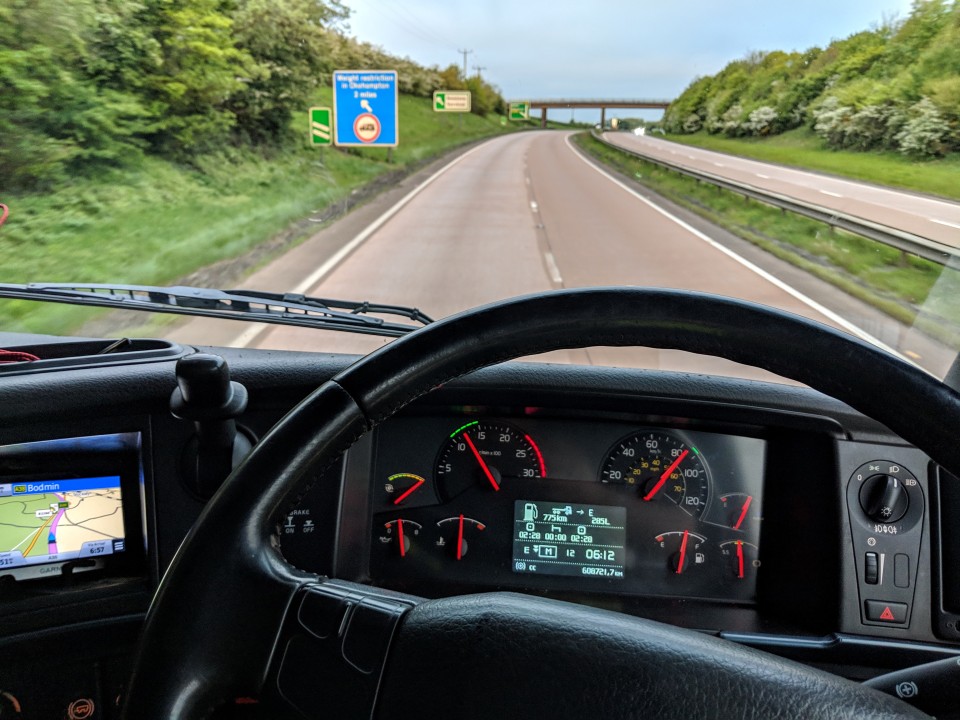
Susie Jones
Keder du dig på vejen?
Oprettet: 27.08.2024
•
Opdateret: 27.08.2024
Den gennemsnitlige lastbilchauffør tilbringer ca. 12 timer bag rattet hver dag. Endeløs tid på landevejen kan lyde tiltalende, men virkeligheden er en stærk kontrast. Utallige tankstationer, rastepladser og lange arbejdsdage kan blive kedsommelige. Truckere tilbringer ofte deres fritid væk fra hjemmet, og det kan være en udfordring at undgå kedsomhed.
Convoys seneste undersøgelse viste, at kedsomhed var en af lastbilchaufførernes største udfordringer. Hvilken effekt har kedsomhed på chaufførernes velbefindende? Og hvordan kan lastbilchauffører holde sig underholdt?
Hvordan kedsomhed påvirker chaufførens velbefindende
Træthed, isolation, ensomhed og mangel på mental stimulering er almindelige bekymringer for chauffører. Nogle chauffører tackler måske disse bekymringer med usunde coping-mekanismer - såsom overspisning, rygning eller overdrevent koffeinforbrug. Over tid kan disse vaner have en negativ indvirkning på den mentale sundhed.
Men efterhånden som snakken om mental sundhed bliver bedre, vælger flere og flere chauffører en anden vej til at bekæmpe det. Vi spurgte lastbilchauffører på Facebook, hvad de gør, når kedsomheden melder sig.
"Lydbøger, hovedsageligt psykologi. Musik, snak med dem, jeg holder af, eller at lytte til radio. Eller jeg slukker for alt og har en fredelig tilværelse med mine egne tanker," siger Nigel.
Andre har nævnt, hvordan det har hjulpet at tale med deres kære over telefonen. Ashleigh siger:
"At tale med mine venner i en gruppechat. Helt ærligt, hvis jeg ikke havde haft dem, var jeg stoppet for længe siden. Vejen byder på noget skidt, og uden at tale med rigtig gode venner ville jeg aldrig have overlevet."
På samme måde mener Karl, at en "gruppechat med venner er et must."

Forebyggelse af kedsomhed bag rattet
I modsætning til hvad mange tror, er lastbilkørsel en fysisk opgave - chauffører har brug for koordination og koncentration for at undgå ulykker. På trods af dette kan det medføre træthed at sidde bag rattet i længere perioder. Risikoen for at blive selvtilfreds på jobbet kan opstå, især hvis en chauffør kender sin rute godt. Hvordan kan chauffører håndtere selvtilfredshed bag rattet?
Uanset om det er at lytte til en podcast eller en iørefaldende melodi, skal bilisterne vælge noget, der holder deres sind vågent. Vi har samlet en liste over ting, der kan forhindre kedsomhed bag rattet.
Podcasts: Lastbilchaufføren Marty lytter til "dusinvis af podcasts", mens han kører. Podcasts er en fremragende måde at afveksle på og lære noget nyt. Tjek denne [nyttige liste over podcasts om lastbilkørsel] (https://www.alltruckjobs.com/blog/trucking-podcasts-better-radio/)
Musik: "Musik, musik og musik" er Richards kedsomhedsbryder. Uanset om det er at lytte til radio eller synge med på en playliste, er musik en fremragende måde at holde sindet vågent på.
Tag en pause: Selv om chauffører har strenge deadlines og regler for fartskrivere, hjælper det at komme ud af førerhuset, når kedsomheden melder sig, med at genfinde fokus.
Kedsomhed under nedetid
Lastbilchauffører står over for ekstra udfordringer, når de skal underholde sig selv efter deres vagt. Det er vigtigt at tage en proaktiv tilgang til at forhindre kedsomhed i denne periode. Vi har samlet en liste over måder at fordrive tiden på.
Beliggenhed: Truckstops, der tilbyder en lang række faciliteter og en fælles stemning, er en fremragende måde at afhjælpe kedsomhed på. Nogle fungerer som et socialt knudepunkt, hvor truckere kan dele lignende oplevelser. Gå ind på vores [locations page] (https://www.snapacc.com/locations/?lang=EN) for at se, hvilke faciliteter vores SNAP-servicepartnere tilbyder
Træning: En daglig gåtur eller kreativ træning kan forhindre kedsomhed og sikre, at du holder dig i form og sund. Se vores tips til [at holde sig sund på vejen] (https://snapacc.com/newsroom/how-to-be-a-healthy-truck-driver/)
Streamingtjenester: Se den seneste tv-serie eller scroll gennem de sociale medier. Lastbilchaufføren Steve kan godt lide at "scrolle og kommentere på Facebook og se Netflix" for at få tiden til at gå.
Hobbyer: Mulighederne er uendelige. Lær et instrument, lær et fremmedsprog, tegn, skriv og meget mere. En hobby er en effektiv måde at forebygge kedsomhed på.
Madlavning: Der er mange fordele ved at lave mad i førerhuset. Ikke alene forhindrer det kedsomhed, men det sparer også penge og er sundere.
Hold kontakten med dine kære: En lastbilchaufførs fritid er den perfekte mulighed for at kontakte sine nærmeste. Videoopkald er en effektiv måde at føle sig tættere på familie og venner.
Slap af: Lastbilchauffører kan komme ud for stressende situationer. At slappe helt af efter et skift kan forbedre chaufførens velbefindende. Afslapningsteknikker som dybe vejrtrækningsøvelser og meditation reducerer stress.
Selvom nogle chauffører nyder den ensomhed og uafhængighed, som den åbne vej tilbyder, er det stadig en udfordring for mange at bekæmpe kedsomhed. På grund af jobbets karakter oplever lastbilchauffører ofte lange perioder med kedsomhed. Men for at forbedre trivslen, arbejdsglæden og trafiksikkerheden skal de finde måder at afhjælpe den på. Uanset om det drejer sig om at fokusere på opgaven, lytte til radio eller chatte med venner og familie, kan de fleste lastbilchauffører finde en løsning, der fungerer for dem.

Hvor sover lastbilchauffører?
De fleste chauffører sover i deres førerhus, da det er veludstyret til en behagelig nattesøvn. Et almindeligt sovekabine har en seng, opbevaring, lys og stikkontakter - det gør det til et hjem væk fra hjemmet.
På grund af den nuværende mangel på parkeringspladser i Europa parkerer mange bilister på rastepladser. Det anses for at være usikkert og gør chaufføren sårbar over for tyveri. Fra november 2017 skal lastbilchauffører i Storbritannien tage regelmæssige ugentlige hvilepauser på ordentlige rastepladser (som serviceområder og rastepladser).
[SNAPs Depot Parking-ordning (https://snapacc.com/depot-parking) giver flåder mulighed for at tilbyde deres lastbilparkeringspladser til netværket, hvilket afhjælper manglen og hjælper chauffører med at undgå sårbare situationer. Derudover tilbyder SNAP over 450 servicepartnere i hele Europa, hvor chaufførerne kan parkere. Gå til vores kortside for at få mere at vide.
Hvorfor lader lastbilchauffører deres trailerdøre stå åbne?
Hvis du nogensinde har kørt ned ad en hovedvej om natten, har du måske lagt mærke til lastbiler, der er parkeret med åbne trailerdøre. Mange chauffører gør det for at afskrække tyve, fordi de antager, at der ikke er noget at stjæle, hvis trailerdøren er åben. Det sker især på trailere med gardin, da det forhindrer tyvene i at skære gardinet op for at se, hvad der er indeni.



